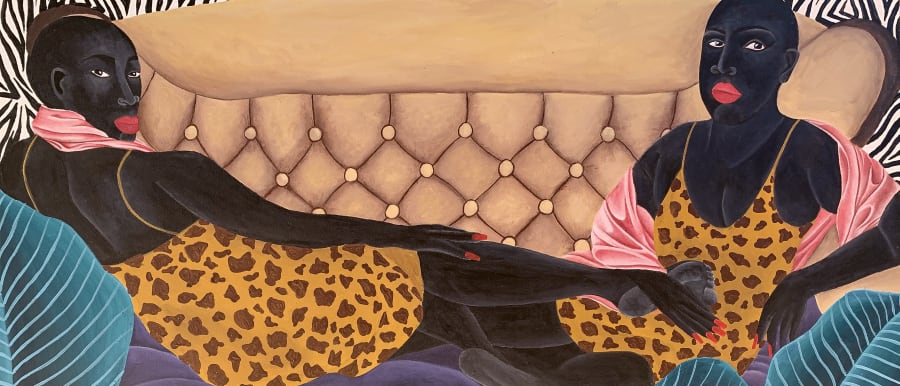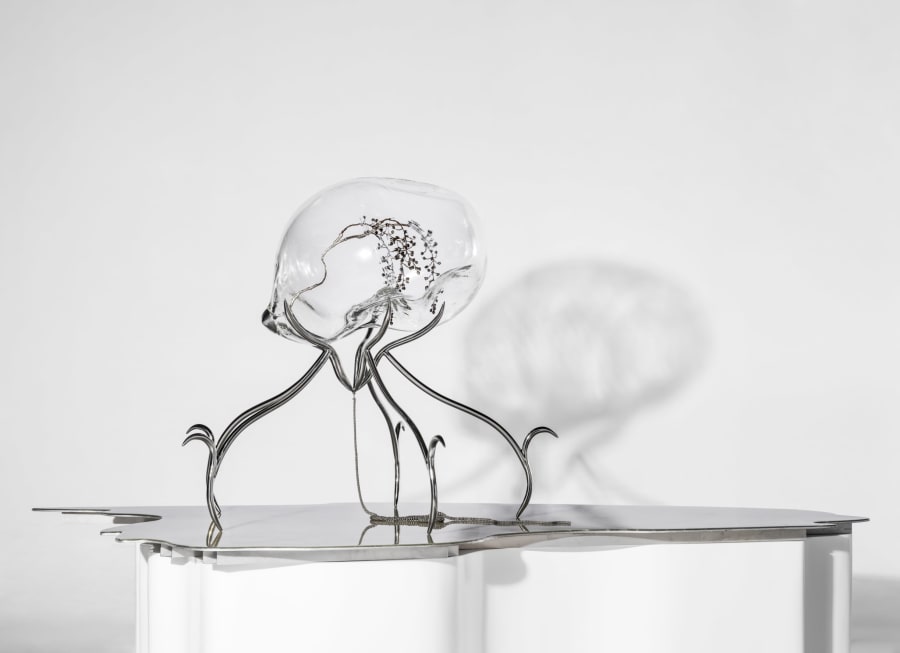Conversations, Art Basel’s flagship talks program, marks its 20th anniversary this year. Over the past two decades, the fair has provided a unique platform for some of the world’s most inspiring cultural figures. Among them was Albert Hofmann, the Swiss chemist whose momentous discovery of lysergic acid diethylamide – LSD – in 1938 ushered in the counterculture of the 1960s. Hofmann died in 2008 aged 102 but his words, captured in this exchange with Hans Ulrich Obrist held at Art Basel in 2004, offer a window into the mind that unlocked one of the world’s most potent and consciousness-expanding compounds.
Hans Ulrich Obrist: How did you become a chemist?
Albert Hofmann: As a child I already had visions – as I would again later in life under the influence of LSD. Once, in a forest, I had a vision about the miracle and mystery of matter, of the material world. What is matter? This question obsessed me, which is why I eventually became a chemist. I believed there was nothing more wonderful.
Tell me about the journey that led you to the discovery of LSD.
I was looking for a research job where I could work with nature, so I took a position at the Sandoz Research Institute in Basel. I was isolating active substances from drugs used to produce medicines. One of the most interesting ones was ergot, an old drug – and a poison – used by midwives to accelerate birth. My job was to isolate the effective principle of ergot – ergobasine – and synthetize lysergic acid propanolamide. From this I managed to synthesize other substances, like lysergic acid diethylamide, which was intended as a cardiac stimulant but when it was tested in laboratories nothing interesting was found. Common ergot assists, so to speak, physical birth, whereas LSD causes a mental rebirth, and became a kind of mental ‘birth inducer’.
You have said, ‘LSD made the whole mythology of the miracle drug manifest.’ What did you mean?
In ancient times, secret cults consumed plants and mushrooms that had such a profound effect that only a priest could use them. They offered a new way of experiencing the universe and were treated as sacred. But when contemporary scientists studied them, they believed that these ancient, sacred cults had been nothing but fantasies. Professor Heim in Paris asked us whether we wanted to reinvestigate some of these substances. We ate a fraction of the mushroom to demonstrate that these sacred plants did contain LSD-related substances. The experiment revealed and explained – structurally, chemically, and pharmacologically – the sacred drugs that have been used since antiquity. Thus proving it was not superstition. It was knowledge, sacred knowledge.
What happened on April 19, 1943, when you experimented with LSD on yourself?
I synthesized LSD – lysergic acid diethylamide – in 1938. A few years later, I thought to myself, I should look into it more. The laboratories in America hadn’t found anything because they had only tested on animals. I knew we had to try it ourselves. I liked the structure, so I produced it again in 1943. While working, I reached an overpowering state of bliss without knowing where it came from. I had to leave the laboratory and drive home to recover.
The next day, I wanted to find out what had made me so curiously happy. I investigated various substances, among them lysergic acid diethylamide. I was cautious: As I hadn’t ingested anything, I knew that it had to be something very potent. I took only a quarter of a thousandth of a gram to see whether it was this substance that had given me that spontaneous feeling of happiness. But I exceeded the dose fivefold. Instead of the beautiful, marvelous experience I had had the first time, this was a horror trip. It was close to what Aldous Huxley described in his seminal novel about LSD, Heaven and Hell [1956]. The experience depends on the circumstances; hell can become heaven or heaven becomes hell. Anything is possible. One needs to prepare carefully beforehand before unleashing LSD’s full potencies and capabilities.
The artists Carsten Höller [Hofmann, 1998] and Rodney Graham [The Phonokinetoscope, 2001] have made films based on your famous bicycle trip.
Once I had taken the lysergic acid diethylamide, an enormous tension started to develop and I wanted to go home. As I did not have a car at my disposal, I went by bike and asked my assistant to accompany me. I had the feeling that I couldn’t budge. My sense of time had left me: I was without time. The ride back to my home in Bottmingen is about ten kilometers, and that was the so-called ‘trip,’ as LSD later became known in America. Every year on the birthday of LSD, students come to Basel and then take this ride from the Sandoz Research Institute to Bottmingen.
You’ve described LSD as a kind of catalyst.
LSD simultaneously stimulates all five of our senses. You see colors more intensely, you hear better. I did LSD experiments with Ernst Jünger, the well-known writer. Before he had not been interested in music, but through LSD he discovered a whole new world. It is almost as if someone who has been blind before is suddenly able to see. After all, our consciousness is generated by everything that comes in through our sensory organs. If these sensory organs – ‘the doors of perception’ – are opened, then you see a different world. If they then are opened too wide, you’ll see hell. If you open just the right amount, you’ll see heaven.
How did Cary Grant contribute to making LSD more popular among non-scientists?
Cary Grant turned out to be one of the biggest promoters of LSD for its psychedelic use. It was in 1959. At that time, a friend from America sent me an issue of Look magazine with an article on Grant entitled ‘Curious Story Behind the New Cary Grant’. On the cover was a photo of Grant, looking radiant, with a very pretty young woman. In the article, he told the reporter that he felt alienated and had undergone numerous therapies, but that nothing had helped him. He explained that he had now been in psychotherapy in California and, as part of this psychoanalysis, he had been given LSD and had found his ‘center.’ He talked about how he was a new person, that he now knew the meaning of life, knew what love was, had discovered his inner strength, and could now also make a woman happy. He said he had found his fourth wife and was a happy man.
LSD has become something of a ‘peace drug’ based on its association with the peace movement. What happened when the CIA took notice of it?
LSD was introduced to the hippies who were enthusiastic about the new visions and the new worlds they were experiencing while under its influence. The CIA quickly realized that LSD played a major role in the peace movement of the 1960s and they wanted to suppress this movement. They worked with all the possible instruments of propaganda against LSD. The first step was to have terrible stories told about LSD in the mass media. Millions of people took LSD and, of course, there were many cases that were unfortunate, which ended up being the ones that were strongly emphasized. The CIA went as far as falsifying scientific publications. There was a respectable journal that claimed that women who had been taking LSD would give birth to malformed children. Afterwards it was proven that these reports were forged and had been specially commissioned.
A prohibition was issued by the Health Department – a total ban of LSD production, possession, and use – bringing scientific research to a standstill. It was a political decision. The intention was to take the drug away from the anti-Vietnam and anti-establishment movement of the young people. In the streets, it did no good at all. The tragic thing was that a miracle drug was suddenly changed into a diabolic drug. That really concerned me. Nowadays psychiatrists without special permission still have to make a huge effort to be able to work with it.
Could LSD be relevant today?
The issue is really how to reintegrate LSD, these alterations of consciousness, once again into our culture. We live in a kind of machine world, removed from nature, so it is difficult to deal with these substances. LSD and related plants make us see the difference between the man-made world – the technical world – and the natural world – the living world that arrives every spring, the one that we have right in front of our eyes that we don’t see anymore. LSD makes us see what is eternal, what is holy, what is really the meaning of our life. It opens our mind to the deeper reality, the one that is living, the one you cannot buy, the one that is free if you keep your eyes open.
Your relationship to literature seems important. You had a very close dialogue with Aldous Huxley toward the end of his life. He had just completed Island [1962], his last novel.
I was in the laboratory when the phone rang: ‘This is Aldous Huxley speaking.’ I couldn’t believe it! I knew his books. He invited me and my wife to dinner in Zurich. At dinner, we had a very nice conversation about his book Island where a drug played an important role. The story takes place on an island where a modern man encounters a primitive culture – a mix of ancient culture and new technology. Moksha medicine plays the decisive role in the life of the culture. It is handed out three times: at reaching maturity, then midlife, and then again upon dying. Moksha medicine is your LSD, your Psilocybin. Huxley asked his wife to give him LSD when he was dying.
What would be your advice to a young chemist, artist, or writer?
To somehow contribute – through literature or through the fine arts. To stay with what is alive, with nature. Nature is alive and is here to open one’s eyes. I believe that great art somehow opens our eyes – those are the great artworks. I don’t think art which aims to access the technical world can make people happy. Artworks that lead back to nature and contain nature, sing the praise of nature, praise the beauty of nature – those are great artworks for me. They open our eyes to the beauty of creation.
Hans Ulrich Obrist is the Artistic Director of Serpentine, London, and Senior Advisor at LUMA Arles.
This interview was conducted in Swiss German and took place at Art Basel in Basel, Switzerland, in 2004. It was re-edited for this publication.
During Art Basel in Basel 2024, selected panels from the Conversations video archive will be screened in the auditorium on June 10th and 12th from 4-8pm and on June 15 and 16 between 11 and 6pm. Discover the full archive here.
Caption for header image: Rodney Graham, The Phonokinetoscope (film still), 2001. © The Estate of Rodney Graham.
Caption for full-bleed video: Rodney Graham, The Phonokinetoscope (extract), 2001. © The Estate of Rodney Graham.
Published on May 29, 2024.


